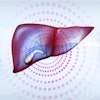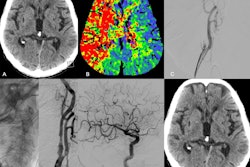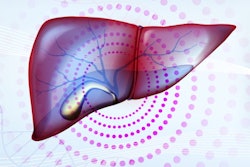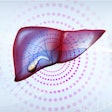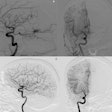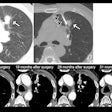Endovascular thrombectomy (EVT) improves functional outcomes and reduces mortality compared to medical management in stroke patients over 90 years old, researchers have reported.
The finding is from a comparison between the approaches among 149 patients with acute large vessel occlusion (LVO) and suggests that advanced age alone should not preclude consideration of EVT, noted lead author Xiaobo Guan, MD, of the First Affiliated Hospital of Xinjiang Medical University in Urumqi, China, and colleagues.
“With increasing life expectancy and population aging, the incidence of [acute ischemic stroke] among nonagenarians is rising. This trend presents a growing clinical challenge, as the benefit-risk profile of EVT in this very elderly population remains unclear,” the group wrote. The study was published on October 25 in Academic Radiology.
EVT is a minimally invasive image-guided surgical procedure used to dissolve blood clots in stroke patients, and thus restore blood flow (reperfusion) to prevent further brain damage. The procedure has emerged as standard care for acute ischemic stroke due to LVO, yet few clinical trials supporting its use have included participants older than 90, the researchers explained.
To address the knowledge gap, the group assessed outcomes among 52 patients who received EVT (34.9%) and 97 who received best medical management, or BMM (65.1%), at their hospital between January 2020 and December 2024.
All patients arrived within 24 hours of symptom onset, with LVO confirmed by an initial CT angiography scan. The median age across the cohort was 92 years old (range, 90 to 95), with men accounting for 41.6% of participants.
The BMM group received intravenous thrombolysis, antiplatelet or anticoagulant therapy, neuroprotective agents, or other supportive measures. Patients who later underwent rescue thrombectomy due to clinical deterioration were still classified under the BMM group, as EVT was not part of the initial treatment decision, the researchers noted.
EVT was significantly associated with better functional outcomes at 90 days compared to BMM, based on modified Rankin scale scores (a scale between 0 and 2 for measuring function after stroke).
According to the results, the proportion of individuals achieving functional independence at 90 days based on modified Rankin scale scores (mRS, 0-2) was greater in the EVT group than in the BMM group (15.4% vs. 7.2%, p = 0.04). Also, the proportion of patients achieving a favorable outcome (mRS, 0-1) was higher with EVT than with BMM (6.9% vs. 2.2%), although this difference did not reach statistical significance, the researchers added.
“Our findings suggest that advanced age alone should not preclude consideration of EVT, and that carefully selected patients in their nineties may still derive meaningful clinical benefit from timely reperfusion,” the group wrote.
Ultimately, however, the overall clinical outcomes for patients remained poor, with mortality at 90 days high in both groups (EVT, 40.2%; BMM, 57.2%), which underscores “the need for realistic expectations and individualized treatment decisions,” the researchers noted.
Further research to optimize patient selection and post-procedural care in this high-risk group is warranted, the group concluded.
The full study is available here.

